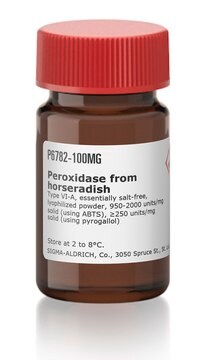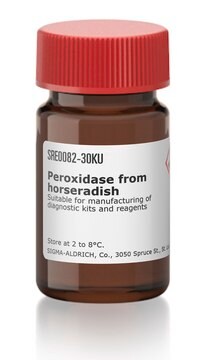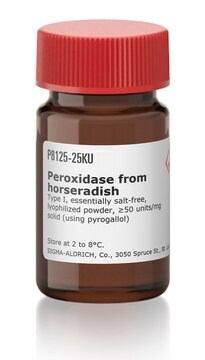93014
Manganese peroxidase from white-rot fungus (Phanerochaete chrysosporium)
powder, light brown, ≥10 U/g
Synonym(s):
Manganese-dependent lignin peroxidase, MnP, Peroxidase, manganese
Sign Into View Organizational & Contract Pricing
All Photos(3)
About This Item
CAS Number:
MDL number:
UNSPSC Code:
12352204
NACRES:
NA.54
Recommended Products
biological source
fungus (white-rot fungus (Phanerochaete chrysosporium))
form
powder
specific activity
≥10 U/g
greener alternative product characteristics
Waste Prevention
Design for Energy Efficiency
Learn more about the Principles of Green Chemistry.
sustainability
Greener Alternative Product
color
light brown
greener alternative category
shipped in
wet ice
storage temp.
−20°C
Looking for similar products? Visit Product Comparison Guide
General description
We are committed to bringing you Greener Alternative Products, which adhere to one or more of The 12 Principles of Greener Chemistry. This product has been enhanced for energy efficiency and waste prevention when used in fuel cell and cellulosic ethanol research. For more information see the article in biofiles and Enzymes for Alternative Energy Research
Application
Manganese peroxidase from white-rot fungus (Phanerochaete chrysosporium) is from the peroxidase family and is used to oxidize manganese. It may be used to study wound healing.
Biochem/physiol Actions
Manganese peroxidase catalyzes the oxidation of Mn2+ to Mn3+. Mn3+ is then in complex with oxalate, which is able to oxidize lignin. Manganese peroxidase from Phanerochaete chrysosporium binds 2 calcium ions per subunit. It binds 1 heme B (iron-protoporphyrin IX) group per subunit .
Unit Definition
One unit corresponds to the amount of enzyme, which oxidizes 1 μmole Mn2+ per minute to Mn3+ at pH 4.5 and 25 °C
Physical form
Supplied as a lyophilized powder containing ~50% sodium tartrate
only partially soluble in water or buffer
Other Notes
This product is supplied as a mixture of isozymes, mol. mass (40-65 kDa).
Signal Word
Danger
Hazard Statements
Precautionary Statements
Hazard Classifications
Resp. Sens. 1
Storage Class Code
11 - Combustible Solids
WGK
WGK 3
Flash Point(F)
Not applicable
Flash Point(C)
Not applicable
Personal Protective Equipment
dust mask type N95 (US), Eyeshields, Gloves
Choose from one of the most recent versions:
Already Own This Product?
Find documentation for the products that you have recently purchased in the Document Library.
Customers Also Viewed
Almasul Alfi et al.
Journal of bioscience and bioengineering, 128(3), 290-295 (2019-04-08)
Manganese peroxidase (MnP) is a fungal heme-containing enzyme which oxidizes Mn2+ to Mn3+, a diffusible and strong non-specific oxidant capable of attacking bulky phenolic substrates. Therefore, MnP is indispensable in the polymer and paper industries. Previous attempts of MnP expression
Pratibha Yadav et al.
Indian journal of biochemistry & biophysics, 49(1), 42-48 (2012-03-23)
Mn-peroxidase (MnP), a biotechnologically important enzyme was purified for the first time from a plant source Musa paradisiaca (banana) stem, which is an agro-waste easily available after harvest of banana fruits. MnP was earlier purified only from the fungal sources.
Haluk Ertan et al.
Biochimie, 94(5), 1221-1231 (2012-05-16)
Isothermal titration calorimetry (ITC) was developed for measuring lignin peroxidase (LiP) and manganese peroxidase (MnP) activities of versatile peroxidase (VP) from Bjerkandera adusta. Developing an ITC approach provided an alternative to colorimetric methods that enabled reaction kinetics to be accurately
Ya-Chen Dong et al.
Bioprocess and biosystems engineering, 35(5), 751-760 (2011-11-26)
The lignin-modifying enzymes (LMEs) play an important role in decomposition of agricultural residues, which contain a certain amount of lignin. In this study, the production of LMEs by three co-cultivated combinations of Phlebia radiata, Dichomitus squalens and Ceriporiopsis subvermispora and
Elsa Contreras et al.
Biotechnology progress, 28(1), 114-120 (2011-10-18)
White-rot fungi (WRF) are capable of degrading complex organic compounds such as lignin, and the enzymes that enable these processes can be used for the detoxification of recalcitrant organopollutants. The aim of this study is to evaluate a system based
Our team of scientists has experience in all areas of research including Life Science, Material Science, Chemical Synthesis, Chromatography, Analytical and many others.
Contact Technical Service










